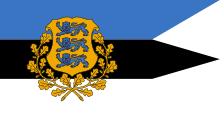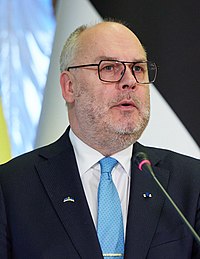This article needs additional citations for verification. (October 2021) |
| President of the Republic of Estonia | |
|---|---|
| Eesti Vabariigi President | |
 Presidential Standard | |
since 11 October 2021 | |
| Style | Mr President (informal) His Excellency (diplomatic) |
| Type | Head of state |
| Residence | Presidential Palace, Tallinn |
| Appointer | Riigikogu / Electoral College (alternately until a candidate reaches the required majority) |
| Term length | 5 years, renewable once consecutively |
| Constituting instrument | Constitution of Estonia |
| Inaugural holder | Konstantin Päts |
| Formation | 24 April 1938 |
| Abolished | 1940–1991 |
| Deputy | Speaker of the Riigikogu |
| Salary | €6,661.77 monthly[1] |
| Website | president |

 |
|---|
The president of the Republic of Estonia (Estonian: Eesti Vabariigi President) is the head of state of the Republic of Estonia.[2] The current president is Alar Karis, elected by Parliament on 31 August 2021, replacing Kersti Kaljulaid.[3]
Estonia is one of the few parliamentary republics in which the president is a ceremonial figurehead without even nominal executive powers. The president is obliged to suspend their membership in any political party for the term in office. Upon assuming office, the authority and duties of the president in all other elected or appointed offices terminate automatically. These measures should theoretically help the president to function in a more independent and impartial manner. The president holds office for five years. They may be elected any number of times, but not more than twice consecutively.
In Estonia, the president is elected by the Riigikogu;[4] a candidate must win a two-thirds supermajority to be elected. If no candidate achieves two-thirds support in the Riigikogu after three rounds of balloting, a special electoral body is convened comprising all members of the Riigikogu and elected representatives of all municipalities (at least one representative per each municipality, but not more than 10 representatives depending on the number of citizens with voting rights residing in the municipality). This body chooses between the two candidates with the largest percentage of votes.
While this election process has been criticised, the idea of direct elections does not have enough support in parliament, with only Estonian Centre Party and Conservative People's Party defending it.[5][4][6][7]
- ^ Mihhailov, Sergei (19 March 2021). "Tippametnike ja -poliitikute palk tõuseb aprillist umbes saja euro võrra" (in Estonian). ERR. Retrieved 11 October 2021.
- ^ "Institution of the president". Estonica.org. Retrieved 15 October 2022.
- ^ "Biography of the President". President.ee. Retrieved 15 October 2022.
- ^ a b YLE: Viron presidentinvaali on ajautumassa kaaokseen jo toista kertaa peräkkäin – "Instituutio kyntää pohjamudissa", sanoo politiikan tutkija (in Finnish)
- ^ Euronews: Why is no one stepping forward to be Estonia's next president?
- ^ YLE: Viron parlamentti kokoontui tänään valitsemaan presidenttiä – mutta miksi prosessi on niin sekava? Yle kokosi viisi kysymystä ja vastausta (in Finnish)
- ^ YLE: Presidentinvaalin ensimmäinen äänestys ei tuonut tulosta Virossa – Alar Karisin presidenttiys jäi viiden äänen päähän (in Finnish)
